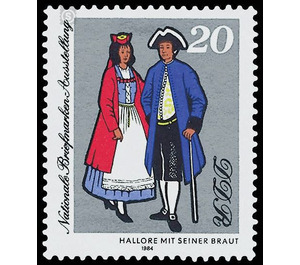Commemorative stamp series - Germany / German Democratic Republic 1984 - 20 Pfennig
Theme: Art & Culture
| Country | Germany / German Democratic Republic |
| Issue Date | 1984 |
| Face Value | 20.00 |
| Color | grey |
| Perforation | K 14 |
| Printing Type | offset |
| Stamp Type | Postage stamp |
| Item Type | Stamp |
| Chronological Issue Number | 2625 |
| Chronological Chapter | GER-DDR |
| SID | 86195 |
| In 21 Wishlists | |
National Stamp Exhibition of the GDR 1984 On the occasion of the National Stamp Exhibition of the GDR in 1984 in Halle, the Ministry of Posts and Telecommunications of the German Democratic Republic issued two multicolored special postage stamps, one of them with surcharge. The surcharge will be made available for the event. Special stamp from 3 July to 2 September National Stamp Exhibition "DDR 84", on the occasion of the 35th anniversary of the GDR in Halle From 6 to 15 July 1984, the National Stamp Exhibition "DDR" will be held in the exhibition halls of the Kulturpark Saaleaue on the Peißnitz island of Halle 84 "instead. It is organized by the Philatelistenverband in the Cultural League of the GDR and is entirely dedicated to the 35th anniversary of the German Democratic Republic. With its approximately 250 philatelic exhibits from all districts of the GDR, it will give a representative overview of the possibilities of a modern socialist philately, which is an integral part of cultural folk art. Especially with the thematic collections, the "GDR 84" will document the 35-year development of our republic, it will reflect the successes in many areas of social life, the path taken under the leadership of the working class and its Marxist-Leninist party and the prospects of further development of the developed socialist society. The "DDR 84" is the eighth highlight in the history of National Stamp Exhibitions. It was preceded by the I. DEBRIA (= German Stamp Exhibition) in Leipzig in 1950, the II. DEBRIA in Berlin on the occasion of the 10th anniversary of the Republic in 1959, and the performance shows on the 15th anniversary of the GDR in Berlin in 1964, the 50th anniversary of the Great Socialist October Revolution 1967 in Karl-Marx-Stadt and for the 20th, 25th and 30th birthday of the GDR in 1969 in Magdeburg, 1974 in Karl-Marx-Stadt and 1979 in Dresden. At all National Exhibitions, Deutsche Post also issued postage stamps to the GDR. For the "GDR 84" issue, Halloren chose a theme typical of the city of Halle. Rich brine occurrences presumably determined the lives of the people in the area of the present city Halle already in the Neolithic and the Bronze Age. Its economic development and flowering since the Middle Ages is closely connected with the salt works, which remained mainstream until the 18th century. The name Halle itself goes back to the Celtic word "hall" as the name of the "site of salt extraction". The work in the salt works of Halle's salt works was carried out by financially strong entrepreneurs, the so-called "Pfännern". These determined for centuries the amount and extent of the salt production, made profit from it, dominated thanks to their money the advice of the city and made all important decisions. They were in the documented since 1276 documented Pfannnerinnung. The process of production itself broke down into a whole series of spheres of activity in which wage laborers of very different qualifications were needed, whose social position differed according to their distinctively important position in the production process. At the brine fountain, the brethren worked to extract the saline water and carry the brine to the boiling pits. They were the socially worst Salin workers and had their own, very modest professional organization. The salt was extracted from the brine in the boiling huts or quays. Here the salt workers and their servants worked. Carriers finally brought the salt from the boiling huts to the loading yard, from where the transport was organized. All workers involved in salt-boiling, salt-carrying, and salt-loading also joined forces to form a professional organization during the social struggles of the early bourgeois revolution. Thus, there was - recognized since 1524 - the "salt mill brotherhood in the valley to Halle", which had strict laws, acquired in the course of time certain rights and privileges and customs that lasted for centuries. The name Halloren for the members of this fraternity as a linguistically and grammatically corrupted derivation of the Latin name for the Hall people who work on the saline, a. Since the end of the 18th century, the Halle saltworks lost their importance, also played the salt mining fraternity an increasingly minor role. With the cessation of salt boiling in Halle, the history of the Halloren was actually over. But the traditions lived on, above all, in cultural history and are today cultivated in the cultural association of the GDR. In Halle there is a Halloren- and Salinemuseum. The silver treasure of the Halloren is one of the finest collections of artisanal gold and silversmithing. Through exhibitions, lectures and representative events, the customs and costumes of the Halloren are kept alive. The value of 20 Pfennig introduces a Halloren and his bride in the typical festive costumes. The bride wears - it should be noted - a ribbon-decorated crown with originally gilded cloves and white blouse and colorful skirt a thick chain of blooming flowers on the upper edge of the bodice.


